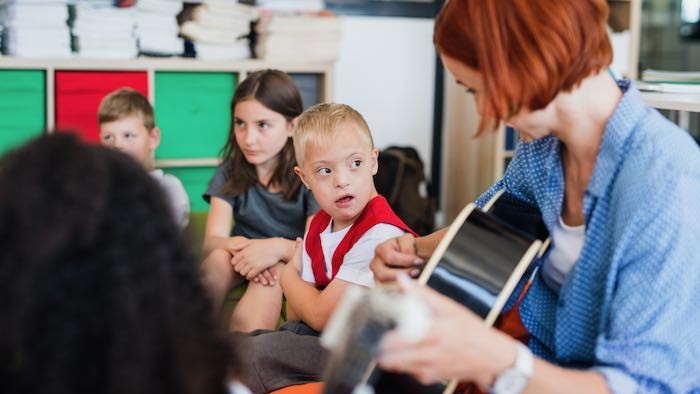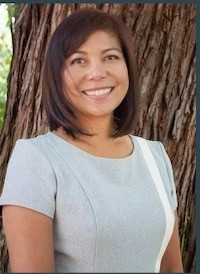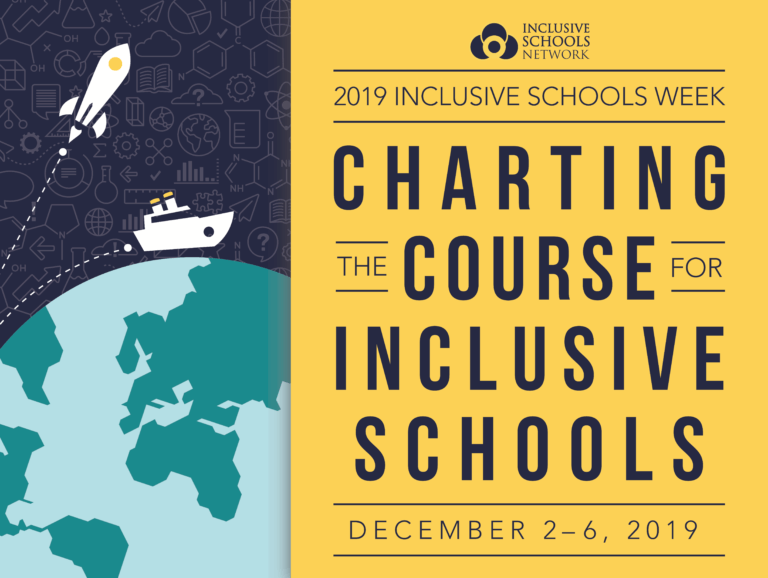Schools Should Include Everyone

Learning Is Better Together
When students with disabilities are educated alongside their peers without disabilities, outcomes improve for students both with and without disabilities. This approach to education is known as inclusive education.
The term inclusion captures, in one word, an all-embracing societal ideology. It is a mindset that drives actions to demonstrate all people are to be valued, appreciated, and included.
 Guest Comment
Guest CommentMarilyn Cachola Lucey
By law, students are to be educated in the least restrictive environment in which they can meaningfully benefit from their education, and for most that is the general education classroom.
In California, we like to think that we are a state of innovators, creative thinkers, and the most progressive and accepting state. When it comes to inclusive education, we are not. According to a 2015 report from a Statewide Special Education Task Force Report, we have "a failure in schools and classrooms to consistently use the very evidence-based practices that are being used successfully in other parts of the country."
“Our prevailing model has made it acceptable, and in some instances seem desirable, to isolate special education as a unique and separate system that parallels general education. This approach defies current research…” — The Statewide Special Education Task Force Report
If the default is to refer a student who doesn’t fit the mold to a separate system of education, there is no impetus for the main education system to become effective and welcoming to all students. The effort is worth the benefits to students and community.
Why Include Students With Disabilities in a Class If the Academic Content Isn’t At Their Level?
There are measures of success and educational values other than academic levels.
For students whose disability impacts their social, communication, attention, or regulation skills, segregating them into a class of students, with the same difficulties, robs them of positive and appropriate peer models. Placing them away from their peer community segregates them and sends a message to the larger community that it is acceptable to exclude them. The underlying message is ‘You don’t belong in here with us’ or ‘I can’t handle your difference’ and just like that, they become second class students.
Currently, exclusion exists in the very institution charged with teaching our children. Imagine if inclusion was rule of the day in schools, and our children learned to naturally expect inclusivity in college, career, and community because it was what they experienced in their PreK - 12 school.
Education is intended to develop the whole child and, by law, students can receive supports and services for functional and academic needs in a general education class.
A Look Through the Lens of Today’s Educational Strategies
A strong inclusion program at your school can support many important instructional strategies.
Trauma-informed. Each child comes to your class with different experiences. Some may have invisible emotional and psychological wounds. Students with disabilities are more likely to be abused and bullied for thinking, learning, and acting differently. Being taught in an inclusive, welcoming and supportive classroom, with exposure to a wider social net of positive relationships, builds resilience. Trauma-informed education means you are aware of these student needs and act on them.
Cultural and Linguistic responsiveness. Consider the disability community as a cultural group and help create a supportive school community. Consider the language of how students with autism or other disabilities communicate or the language of a student who is nonverbal or requires a device because a disability impacts speech. Cultural and linguistic responsiveness matters a great deal to students with disabilities.
SEL Communities of Practice. Social-emotional learning (SEL) is critical for inclusive education. Social emotional learning communities, such as the Collaborative for Academic, Social and Emotional Learning (CASEL), are growing. Student self-awareness, self management, social awareness, relationship skills, and responsible decision making are hindered if a student is educated away from non-disabled peers. How can you make friends, practice appropriate social negotiation, or see yourself as part of your natural community if you are separated from them for a majority of your school day?
Social emotional learning should explicitly include teaching social response skills to students with disabilities, to prevent them from being bullied over time. Reasonably, the development of social awareness in students without disabilities should also include interacting and building friendships with peers with disabilities.
Universal Design for Learning (UDL). Decades ago, the education school at Harvard University envisioned an inclusive approach it called the Universal Design for Learning. When you use UDL, you operate on the assumption that the barriers to learning lie in the environment, not in the student. Learning isn’t only academic but also social.
School climate efforts must recognize that students with disabilities are bullied more than peers without disabilities. When special education kids are separated, it tends to make the challenges larger. One article explains.
“...bullying is used to attain social status in the school network hierarchy, with weak and vulnerable populations comprising ‘easy targets’ and bearing the brunt of abuse. Disabled children are often regarded among such vulnerable groups, occupying marginal positions in school settings (Faris and Felmlee, 2014). The social relational model of disability suggests that such negative perceptions result from structural processes that promote normative assumptions about appropriate childhood development and labelling of children with impairments or needs as ‘others’ through negative representations of difference (Fine and Asch, 1988; Hollomotz, 2012; Holt, 2004; Oliver, 1992; Powell, 2003; Watson et al., 1999).”
This suggests that bullying can be a result of ‘structural processes’ with ‘negative representations of difference’; educating students with disabilities in separate classrooms, away from their peers without disabilities, is an example of that.
Why now?
A convergence of activities is pushing toward more inclusive education.
Adults who lived through their own experiences with educational programs segregated by "ability" have a lot to say about the experience. Members of organizations like ADAPT, Down Syndrome Connection, Autism Self Advocacy Network, and Eye to Eye are using their voices to advocate for acceptance and inclusion.
Teachers of the Year across America agree: Inclusive education is vital (video)
California’s children should not have to wait any longer. Inclusion is already happening in pre-school, elementary, secondary and higher education. (Yes, colleges, too!) Not only are there inclusive education programs but there are teacher and administrator preparation programs to specifically prepare education professionals to provide inclusive education. A roadmap is available. California needs to drive it faster.
The National Center for Learning Disabilities and the Alliance for Excellent Education just launched a campaign for an inclusive vision of 21st century learning, and inclusive technology, among other components.
Policy Perspective
Governor Newsom knows what it is like to struggle to read because of his dyslexia, and he has been bold about issues involving the welfare of children and youth. For example, he created a state surgeon general, signed later school start times into law, and made the expansion of state preschools a funding priority.
Senate Bill 75 asks the legislature to look in the next session at special education reforms, including expansion of inclusive practices to ensure that every individual with exceptional needs has access to learn in the least restrictive environment.
The Department of Education Needs an Inclusive Education Division
As part of the shift in California, I would like to see the Special Education Division become the Inclusive Education Division of the California Department of Education. The language we use matters and influences our perceptions and attitudes.
What Can You Do?
The family, guardians, and educators of individuals with disabilities can introduce the idea of inclusive education with an inclusivity checklist such as this one from Inclusive Schools.
As a first step, invite your PTA, Community Advisory Committee, Climate Committee, Local Control and Accountability Plan Committee, Culturally and Linguistically Responsive trained teachers to assess your school or district together.
 Marilyn Cachola Lucey is a Special Education Advocate with Special Education Advocacy Group. She lives in the San Francisco Bay Area with her amazingly neurodiverse family. She is also an Ed100 Graduate! Follow her on Facebook, Twitter, and Instagram.
Marilyn Cachola Lucey is a Special Education Advocate with Special Education Advocacy Group. She lives in the San Francisco Bay Area with her amazingly neurodiverse family. She is also an Ed100 Graduate! Follow her on Facebook, Twitter, and Instagram.
Tags on this post
Bullying School Climate Social-emotional learning Special edAll Tags
A-G requirements Absences Accountability Accreditation Achievement gap Administrators After school Algebra API Arts Assessment At-risk students Attendance Beacon links Bilingual education Bonds Brain Brown Act Budgets Bullying Burbank Business Career Carol Dweck Categorical funds Catholic schools Certification CHAMP Change Character Education Chart Charter schools Civics Class size CMOs Collective bargaining College Common core Community schools Contest Continuous Improvement Cost of education Counselors Creativity Crossword CSBA CTA Dashboard Data Dialogue District boundaries Districts Diversity Drawing DREAM Act Dyslexia EACH Early childhood Economic growth EdPrezi EdSource EdTech Education foundations Effort Election English learners Equity ESSA Ethnic studies Ethnic studies Evaluation rubric Expanded Learning Facilities Fake News Federal Federal policy Funding Gifted Graduation rates Grit Health Help Wanted History Home schools Homeless students Homework Hours of opportunity Humanities Independence Day Indignation Infrastructure Initiatives International Jargon Khan Academy Kindergarten LCAP LCFF Leaderboard Leadership Learning Litigation Lobbyists Local control Local funding Local governance Lottery Magnet schools Map Math Media Mental Health Mindfulness Mindset Myth Myths NAEP National comparisons NCLB Nutrition Pandemic Parcel taxes Parent Engagement Parent Leader Guide Parents peanut butter Pedagogy Pensions personalized Philanthropy PISA Planning Policy Politics population Poverty Preschool Prezi Private schools Prize Project-based learning Prop 13 Prop 98 Property taxes PTA Purpose of education puzzle Quality Race Rating Schools Reading Recruiting teachers Reform Religious education Religious schools Research Retaining teachers Rigor School board School choice School Climate School Closures Science Serrano vs Priest Sex Ed Site Map Sleep Social-emotional learning Song Special ed Spending SPSA Standards Strike STRS Student motivation Student voice Success Suicide Summer Superintendent Suspensions Talent Teacher pay Teacher shortage Teachers Technology Technology in education Template Test scores Tests Time in school Time on task Trump Undocumented Unions Universal education Vaccination Values Vaping Video Volunteering Volunteers Vote Vouchers Winners Year in ReviewSharing is caring!
Password Reset
Search all lesson and blog content here.
Login with Email
We will send your Login Link to your email
address. Click on the link and you will be
logged into Ed100. No more passwords to
remember!















Questions & Comments
To comment or reply, please sign in .
Jamie Kiffel-Alcheh December 8, 2019 at 2:43 pm
Derby November 21, 2019 at 6:10 pm
Kim Gordon November 19, 2019 at 7:16 pm
November 19, 2019 at 4:04 pm
Kari November 14, 2019 at 9:55 pm
karenfcull November 13, 2019 at 10:51 pm
Surely if we could figure out how to include these most difficult cases, we would be able to make sure everyone is included.
Caryn November 14, 2019 at 10:19 am